The Short Story
The Blue Spruce Routes are gone — but if you don’t have all the equipment, there are still ways to get across the Atlantic. What you can do depends on what’s on board:
Fully equipped? (2 LRNS, CPDLC RCP240, ADS-C RSP180, HF, LOAs)
➤ You can go anywhere in the NAT HLA.
No datalink?
➤ Avoid FL290–410 unless you’re in the DLM Exemption Area (e.g. Iceland–Greenland Corridor) and have ADS-B.
No HF radios?
➤ You can only cross via specific VHF-only routes:
– Above FL195: YFB–SF–KFV
– FL250 and above: YYR–OZN–KFV
Only one LRNS?
➤ Stay below FL285 to avoid HLA nav and datalink rules – but unless you’re on a Gander-approved VHF route (e.g. via OZN or SF), you’ll still need two long-range comms systems.
➤ Want to climb into HLA airspace? You’ll need VHF coverage, ATS surveillance, State approval, and a compliant routing like the Iceland-Greenland corridor.
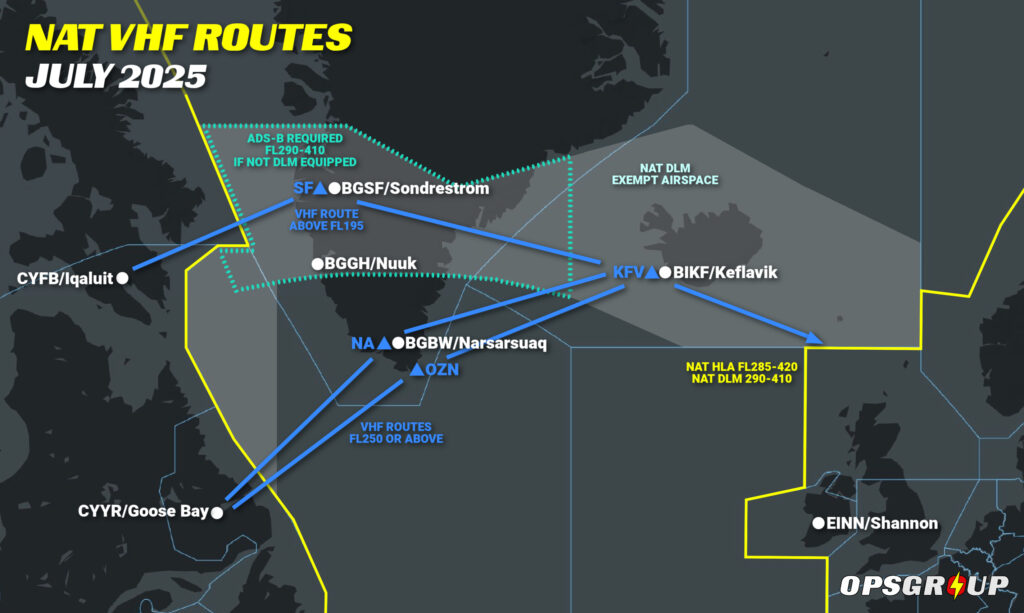
The Longer Story
As of March 20, 2025, the Blue Spruce Routes have been officially removed from the North Atlantic. These routes—once the lifeline for aircraft with limited navigation or communication capability—are now a thing of the past. The change is part of the latest update to NAT Doc 007, which you can read more about here.
Technically established in 1976, the Blue Spruce Routes allowed aircraft with only one Long Range Navigation System (LRNS) to transit the NAT High Level Airspace (HLA) under special routing and coverage provisions. Over time, however, the need for them faded. The reasons:
- Almost no aircraft that have the mandated CPDLC equipment have only one LRNS. Or put another way, if you have CPDLC, you have dual LRNSs unless broken. With the addition of CPDLC requirement, relief for a single LRNS became outdated.
- Ground-based nav aids along the routes have largely disappeared.
- Datalink Mandated Airspace now covers most of NAT HLA.
- The Iceland–Greenland Corridor, with reliable VHF and ATS surveillance, provides a more flexible and better-supported fallback option.
While the Blue Spruce name may still pop up informally (especially among ferry operators), it no longer refers to any officially recognized ICAO routes. But crucially, some of the old routings remain usable—just under new conditions.
For example, Canada now allows aircraft operating with only VHF to cross via specific routes:
- Above FL195 via YFB–SF–KFV (this one currently says “below” FL195 in the Canada AIP, but that’s been confirmed as a typo, and will be getting updated shortly!)
- FL250 or above via YYR–OZN (or NA)–KFV
These are the only routes where VHF coverage is considered sufficient for oceanic ops without HF radios. Everywhere else, HF is still required outside VHF range.
So while the Blue Spruce Routes are gone in name and publication, practical exemptions remain—especially for aircraft with partial equipage. What’s changed is how you plan and justify the crossing.
Let’s walk through what you can still do today, based on what your aircraft has (or doesn’t).
Standard Ops
Most traffic crossing the North Atlantic Airspace (NAT) occurs from FL290-410 through the North Atlantic High Level Airspace (NAT HLA). Over the years, advances in navigation, communication, and surveillance equipment have led to additional requirements for operators so ATC can safely reduce aircraft spacing and pack more aircraft through the airspace.
For unrestricted access to the NAT HLA, operators need:
- 2 Long Range Navigation Systems (LRNSs)
- Outside VHF areas 2 LRCS are required – either 2x HF, or HF & Satcom/or CPDLC, for the other.
- FANS 1/A equipment for the NAT Datalink Mandated airspace
- Super-duper datalink for the coveted PBCS Tracks (i.e. CPDLC capable of RCP240 + ADS-C capable of RSP180)
And for US operators, that equipment list is a prerequisite for several required LOAs:
- A056 CPDLC Enroute, and Oceanic and Remote (PBCS)
- B036 Oceanic and Remote Continental Navigation Using Multiple Long-Range Navigation Systems (M-LRNS), Aka. RNP 4 (and RNP 10)
- B039 NAT HLA
- B046 RVSM
- D195 MEL (not technically required for a crossing, but might as well throw this one in)
The above is the ideal setup. But what if I fly old stuff, or new stuff, or broken stuff, or little stuff?
Old Stuff
To the formerly early adopters without the benefit of factory standard state-of-the-art equipment: let’s say your aircraft has LRNSs that are only capable of RNP 10, or your FANS equipment is RCP400 and RSP400. All else being equal, the only limitation would be no PBCS tracks. And no T9/T290 either. All other tracks or random routes through the HLA are approved.
Is your equipment so old it doesn’t even have the above equipment? Consider yourself the same as broken, and keep reading…
New Stuff
You just closed on a shiny, new, well-equipped jet and have to ferry it across the pond, but you have no LOAs. In this case, you are altitude and route are limited. No RVSM or NAT HLA LOAs means the airspace from FL290-410 is off limits for you. If traffic permits, ATC may let you climb through the HLA above FL410, but you might want to plan fuel and route at FL280. Route-wise, without B036, you’re flying the Iceland-Greenland Corridor.
If you only have some of the above-listed LOAs, also consider yourself broken.
Now, it gets a little more nuanced…
Broken Stuff
You’ve been spoofed, but only one GPS came back? When down to one LRNS (or you don’t have B036), fly the Iceland-Greenland Corridor. With only one LRNS, you could fly through the NAT HLA along the corridor with approval if you stay within surveillance and VHF coverage and have the equipment to fly the assigned route. Otherwise, fly above or below the NAT HLA.
You’re down to one HF or lost both? You can still cross via the Iceland–Greenland Corridor or the old southern Blue Spruce routing via OZN – but only between FL250-280, where VHF coverage is sufficient and you’re still below DLM airspace. Just make sure to stay clear of Shanwick OCA, which still requires HF.
HFs are back, but your Datalink konks out (CPDLC or ADS-C), or you don’t have A056. There are two options: stay within the Data Link Mandate (DLM) exemption area (the corridor) and fly any altitude. The DLM exemption area exists because you don’t need CPDLC in that area if you have ADS-B. Radio reception is pretty good throughout there! The second option is to fly above or below the NAT HLA.
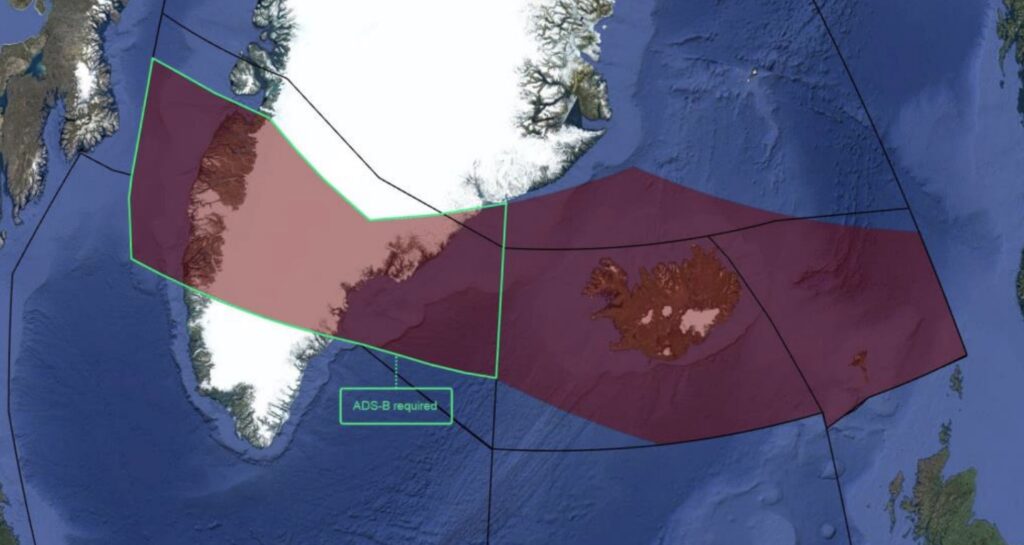
DLM Exemption Area (ie. Iceland-Greenland Corridor)
Little Stuff
And if you get a wild hair to cross the Atlantic in an aircraft with only one LRNS, no HF radios, no Datalink, no LOAs, without the range to fly non-stop (like me), you still have options. You’ll need to stick to the Iceland–Greenland Corridor, or the specific VHF-approved routes via OZN or SF.
What’s a Blue Spruce?
It’s a Christmas tree native to the Rocky Mountains that you won’t see across the Atlantic on any of your stops. However, the Blue Spruce Routes are routes in and around the Atlantic connecting Canada, Greenland, Iceland, and the UK.
Why were they called the Blue Spruce Routes? Back when military aircraft had wooden propellers (sometimes made of spruce), they painted the tips blue. These aircraft had to make the trans-Atlantic journey along the now-known Blue Spruce Routes.
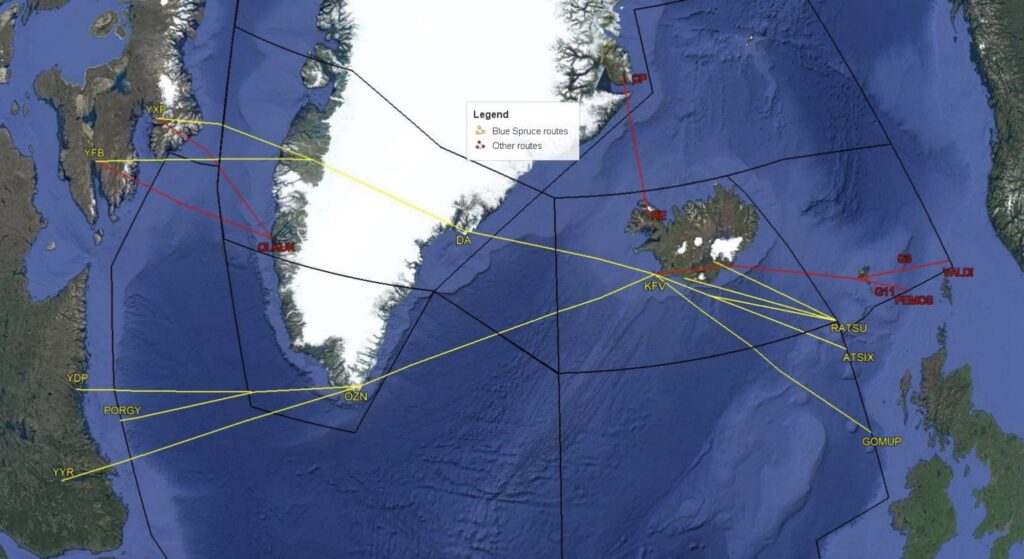
Nostalgia Map.
Gray Areas
The Iceland-Greenland Corridor provides exemptions from equipment and operational requirements because land-based radio transmitters along the route provide decent coverage, and route legs are short enough to complete a crossing without necessitating equipment redundancy.
Now, there are exemptions from the rules, and then there are gray areas. Despite all the relief these routes provide, one regulation remains: you must maintain two-way radio communication with ATC.
So far, much of the discussion is how high you can go, but what about how low?
VHF communications have improved significantly in the Atlantic in the last ten years. Both the northern and southern routes have VHF reception at appropriate altitudes. The longest stretch of water is between Canada and Greenland. On the southern route over this stretch of water, I have experienced adequate communication at FL250 and up. The northern route is good down to FL200. Iceland is fantastic – it’s almost like you’re in domestic airspace.
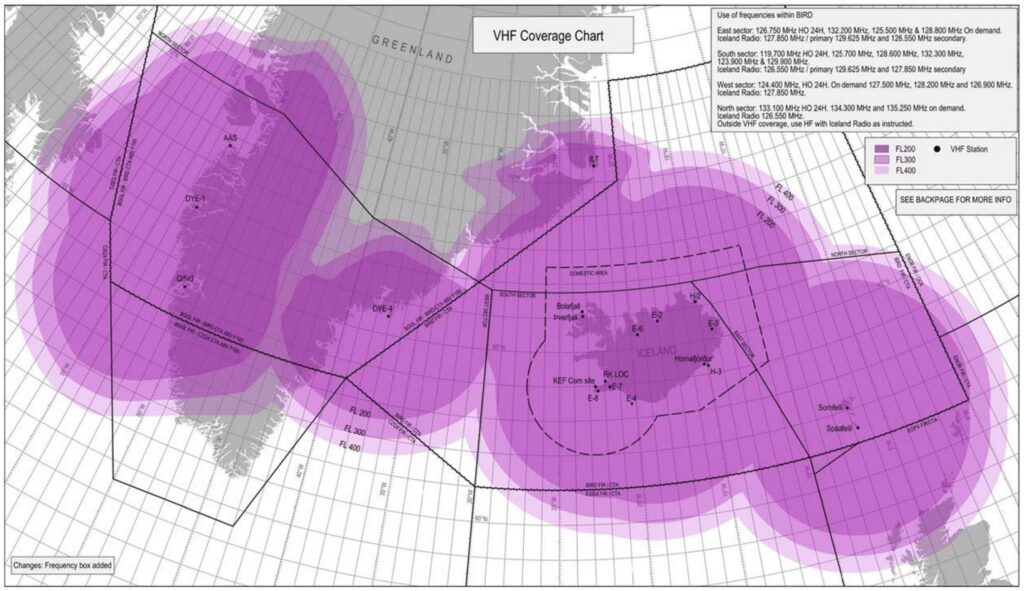
The gray area is when you plan to operate below these altitudes and are counting on using another aircraft to relay position reports. By the letter, this is a no-no. The up-and-up solutions would be to rent a portable HF unit or containerize and ship the aircraft to Europe, both of which can be about $20k.
You can see the incentive to count on relays.
Are ferry pilots bending the rules? Let us descend, inception-style, one further layer down the list of the exceptions: ATC can waive the HF requirement for ferry, delivery, and special event flights. Ferry pilots have all the fun. 😊
What About Aircraft with Only One LRNS?
Back in the day, the Blue Spruce Routes were the go-to option for aircraft with only one Long Range Navigation System (LRNS) crossing the Atlantic. Now that those routes are gone, what are your options?
If you’re staying below the NAT HLA (below FL285), you’re in the clear:
- You don’t need two LRNSs to operate below FL285.
- You’re also free from NAT HLA requirements like RNP 10 and Datalink etc.
- Just make sure your one LRNS (typically GPS-based) is suitable for the route you’re flying.
- You still need two long-range communication systems (HF + HF or HF + Satcom), unless you’re on one of the VHF-only routes approved by Gander that we talked about above (ie. via OZN or SF)
If you want to enter the NAT HLA (FL285–420), it gets more tricky:
You’ll need to qualify under the NAT Doc 007 1.4.1 exception, which says aircraft can operate in the NAT HLA with fewer than the standard requirements only if:
- You stay within ATS surveillance,
- You remain within VHF communication coverage,
- Your navigation system is suitable for the planned route,
- And you have specific State approval to operate with reduced navigation capability.
In practical terms, this means you might be able to fly the Iceland–Greenland Corridor at HLA altitudes, but only if your authority signs off – and probably not straight across via the likes of OZN.
Summing up
You can operate with one LRNS, no HF radios, no CPDLC, and no LOAs using the Iceland–Greenland Corridor or the designated VHF routes published by Canada.
Outside of these specific altitudes and routings, aircraft operating in the NAT Region must normally carry two long-range communication systems, one of which must be HF, when operating beyond VHF coverage – unless a specific exemption has been granted by the State of the Operator or Registry (eg. for ferry or delivery flights).
If you want to learn more, check out myaircraftmanagement.com for a 101-level walkthrough of a Blue Spruce operation.
Happy Crossings! ✈️ 🌊 🧑✈️
More on the topic:
- More: What’s Changing on the North Atlantic
- More: Timeline of North Atlantic Changes
- More: Spoofed Before the NAT? Here’s What to Do
- More: Shanwick Delays OCR Until Post-Summer 2026
- More: Updated FAA Oceanic Guides
More reading:
- Latest: GAR Procedure for UK Flights
- Latest: Venezuela & Caribbean Airspace Update
- Latest: ReFuelEU: Europe’s new anti-tankering rules explained
- Safe Airspace: Risk Database
- Weekly Ops Bulletin: Subscribe
- Membership plans: Why join OPSGROUP?



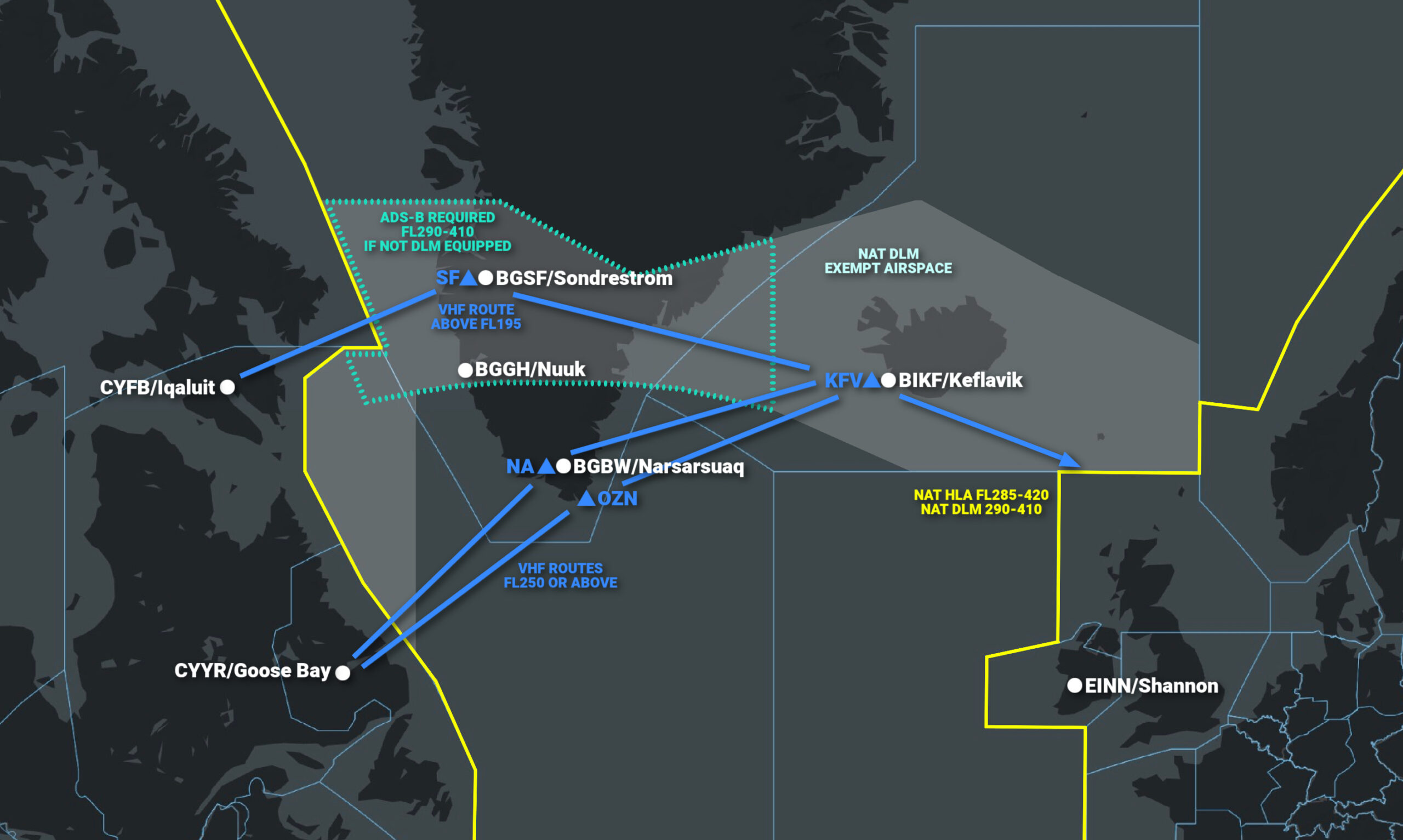







 Get the famous weekly
Get the famous weekly 






I believe a note should be added to the first part of this article to clarify that Canadian operators with only one LRNS can operate in NAT HLA without using the old blue spruce routes. Emphasizing this point would be helpful to avoid any misunderstanding. Although you mention this later in the article, it would be beneficial to expand on this caveat in the initial section. This way, operators outside Canada won’t mistakenly think they need to fly the old northerly blue spruce route for VHF coverage, as the NAT Doc 007 indicates that the ATS Surveillance area over Greenland and Canada meets the necessary requirements.
From Nat Doc 007:
1.4.1 Aircraft that do not meet NAT HLA requirements may be authorized by the state of operator or state of registry as applicable, to operate in NAT HLA if the following conditions are satisfied:
a) The aircraft is being provided with ATS surveillance service;
b) Direct controller-pilot VHF voice communication is maintained; and
c) The aircraft has a certified installation of equipment providing it the ability to navigate along the cleared track.
1.4.2 The areas that satisfy the ATS surveillance and VHF requirements in paragraph 1.4.1 are the Iceland – Greenland corridor, Azores corridor and Bodo corridor detailed in section 1.7.5.
Also stated about the Iceland-Greenland corridor in the nat doc 007:
“This area, which is within direct controller pilot VHF voice coverage, offers a solution for suitably equipped aircraft (transponder with ADS-B extended squitter transmitter) that are equipped with a single or no Long Range Communication System, to cross the North Atlantic at or above FL290.”
Additionally, there is some contention stemming from an excellent article from March, which suggests that one LRNS is sufficient through the ATS Surveillance Area.
ops.group/blog/nat-changes-2025-no-more-blue-spruce-routes/
I believe further investigation may be warranted, as documentation even within the same version of the NAT Doc 007 can sometimes be contradictory. Please understand that I enjoyed the article and am not disagreeing with it; just that further clarity in both articles will help operators navigate these “NAT conundrums”. Thank you all as always for your great work.
Correction: non-Canadian
I believe a note should be added to the first part of this article to clarify that non-Canadian operators with only one LRNS can operate in NAT HLA without using the old blue spruce routes.
Thanks Joe, I’ve added something extra to that first section now. Does it read better now?
Do you have a point of contact to request an HF waiver? I’ll be in a C-47 down at FL060-100 and am not HF equipped.
Dear William, did you get any waiwer or more info to fly below FL200,as you indicate even lower? Thanks, for reply here or by email burian@aircrew.cz +420724672383 We would be even looking to cross Atlantic ferry flight from GVNP (Cape Verde) to SBRF (Recife/Guararapes–Gilberto Freyre in Brazil). For us in L410 at FL140 with no HF around 8:15 hours with Starlink Mini, plus Garmin inReach Messenger Plus. But lets see, if we can do it or fly nothern (Greenland) route.
I think taking delivery of a new jet and flying at FL280 because of a very strict interpretation of the rules is a waste of fuel and ads unnecessary danger to the journey. In the 007 doc they explicitly say that flying at FL280 blue spruce accounts for the vast majority of search and rescue missions.
Call Gandar and ask them. (1) I have no LOAs including no RVSM (2) I can reach FL430 or FL450 before the oceanic entry point (3) I have an HF and a satphone. Will you clear me on my route from USA to Europe at FL430 or FL450? In my experience, they say yes.
Yes, I understand satphone doesn’t mean you are SATVOICE certified and they could ding you on this if you don’t have two HFs. But, again, strict regulation interpretation over safety?
Currently the biggest problem with LOAs seems to be RVSM with Northern Europe. They will keep you at or descend you to FL280. I needed to get from USA to the middle east, with no LOAs. I stopped in Morocco for fuel and kept out of Northern European airspace and all went well. Spain did descend me to FL280 approaching morocco but it was minimal extra fuel for the early descent.
Telling controllers, “I am RVSM equipped and capable, but not authorized” in my experience let’s you climb through (and sometimes cruise in) RVSM outside of Northern Europe.